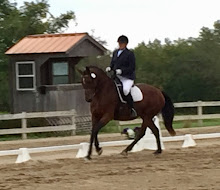If riding dressage was not difficult enough, add to the equation the emotional requirements for doing it well. Lets talk about the emotional state that is optimal for the horse to learn and be emotionally healthy.
Lets say there is a scale from one to ten. One is completely passive and ten is extremely aggressive. The number five is neutral. Horses do the best mentally if the rider uses the emotional range from 3 to 7.
That is the easy part. Deciding where to be on the scale is the hard part. For example, if the horse is frightened, most of the time it is advisable to get quieter or use the gentle side of your emotional range. However, if your horse is frightened and physically in your space, you must increase your emotional state or assertiveness. For me when I do not know the horse very well, I gradually change my emotional state to see if it helps the horse. If the horse's behavior becomes worse I will reverse my emotional state and go the other way.
This is why it is confusing. Some horses use stress to control the ride or the interaction. I always respond to what looks like fear with a softer emotional state at first. I keep careful track of the horse's response. If the horse improves then super! If not. then he is controlling the interaction through his stress. If the horse responds with more stress you know you have gone in the wrong direction. Then the rider must increase their emotional state towards being assertive instead.
Then there is the horse that is just a bit challenging (easier to read). The rider simply needs to go up the emotional scale to assertiveness. The rider needs to not hold a grudge and needs to then return immediately to neutral when the behavior improves. A neutral emotional state is acceptance. Acceptance is a reward.
If this is not difficult enough, then the rider needs to be able to access their emotional state easily between three and seven. But people have personalities and preferences of their own. People have preferences on the emotional scale that they like to use. It is extremely hard to teach yourself the part of the scale that makes you uncomfortable. Some people are simply very nice and like to use their neutral and lower emotional scale. Others are matter of fact and would just like to get it done and are comfortable using the neutral and higher assertive part of their emotional scale.
Horses quite simply need us as riders to use both sides of the emotional scale when we ride. So the bottom line is that it does not matter which side of the emotional scale you prefer to use as a rider, your horse needs both. So in the end, all of us learning how to ride well, are uncomfortable as we learn to use the emotional scale. To do this we need to learn the emotional piece we are weaker at.
Give yourself a break and understand where you naturally fall on the emotional scale. Then try to teach yourself to use the whole range when you ride. The start is knowing where you are emotionally and what you need to be for your horse. Remember your preferred state is very helpful is some situations, just be sure to learn the entire scale.
There is no right or wrong emotional preference, just awareness and then education on what to use when.
Have a great time with your horse!
Subscribe to:
Post Comments (Atom)

No comments:
Post a Comment
Note: Only a member of this blog may post a comment.